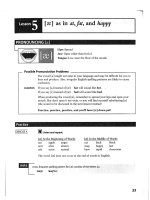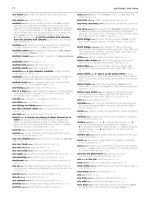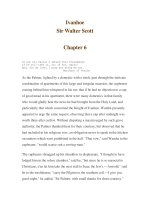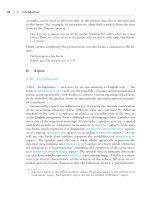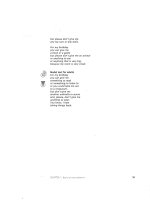Being structure sound 6 pot
Bạn đang xem bản rút gọn của tài liệu. Xem và tải ngay bản đầy đủ của tài liệu tại đây (91.18 KB, 6 trang )
Y
ou’ve learned a lot this week about language and how much it affects meaning. Before you add this
knowledge to the knowledge you already have about structure and the basics of reading compre-
hension, take a minute for a brief review of the last four lessons. It’s always a good idea to stop and
review material you’ve learned before you go on to new material.
Review: Language and Style
Point of view is the perspective from which the writer speaks. Sometimes, writers use the first-person point of view
(I, me, my, we, our, us) to express their personal feelings and experiences directly to the reader. This point of view
creates a sense of intimacy between the reader and the writer because it expresses an extremely subjective per-
spective. When writers use the second-person point of view, they address the reader directly by using the pronoun
you. This point of view is often used to give directions and to make the reader feel directly involved in the action
described by the writer. The third-person point of view is the objective perspective of a “third person,” someone
who is not directly involved in the action or ideas expressed in the passage. This point of view establishes a dis-
LESSON
Word Power:
Putting It All
Together
LESSON SUMMARY
This lesson pulls together what you’ve learned in Lessons 11–14, as
well as in previous lessons. It shows you how to use point of view, dic-
tion, style, and tone to understand what a writer means.
15
111
tance between the reader and writer and uses the pro-
nouns he, his, him; she, hers, her; it, its; and they, them,
and their.
Diction refers to the specific words chosen by the
author to express his or her ideas. Because words have
both a denotation (exact or dictionary meaning) and a
connotation (implied or suggested meaning), as well as
an emotional register, the words an author chooses are
very significant. Authors, like politicians, must choose
their words carefully to express exactly the right idea
with exactly the right impact.
Style is the manner in which the writers express
their ideas in writing. Style is composed of three main
elements: sentence structure, degree of description and
detail, and degree of formality. Some writers use a very
formal style; others may write in a casual style. Certain
styles are best for particular audiences or purposes.
For example, a high degree of formality with specific
details but without any unneccessary description would
be appropriate for business, where time is money and
writers should get to the point as quickly as possible.
Finally, tone is the mood or attitude conveyed by
the writing. Tone is created by a combination of point
of view, diction, and style. Tone is extremely important
in determining meaning because as we noted, a word
as simple as “sure” can have many different meanings
depending upon the tone in which it is said. To deter-
mine the tone, you have to look for clues as to how the
writer wants his or her words to sound.
Practice
In today’s practice, you’ll combine these aspects of lan-
guage with everything else you’ve learned in this book
about reading comprehension:
■
Finding the facts
■
Determining the main idea
■
Determining vocabulary meaning through context
■
Distinguishing facts and opinions
■
Chronological order
■
Cause and effect
■
Compare and contrast
■
Order of importance
Practice Passage 1
Begin with a paragraph someone might see in a local
newspaper: a profile of a town figure. Read the para-
graph carefully, marking it up as you go, and write
your observations in the space provided.
Ms. Crawford has been a model citizen since she
moved to Springfield in 1985. She started out as a
small business owner and quickly grew her busi-
ness until it was one of the major employers in the
region. In 1991, her company was profiled in Busi-
ness Week magazine. Her innovative business model
includes a great deal of community work and
fundraising, the rewards of which have brought deep
and lasting benefits to Springfield and its citizens.
Today, she is being honored with Springfield’s Citi-
zen of the Century Award to honor all her cutting-
edge efforts on behalf of our community.
If any of these terms or ideas sound unfamiliar
to you, STOP. Please take a few minutes to
review whatever lesson is unclear.
– WORD POWER: PUTTING IT ALL TOGETHER–
112
Your Observations:
Now answer the following questions:
1. Ms. Crawford’s company was profiled in Business
Week
a. in 1985.
b. in 1991.
c. today.
2. Which sentence best sums up the main idea of
the paragraph?
a. Ms. Crawford is very smart.
b. Ms. Crawford is a dedicated citizen.
c. Springfield would be nowhere without Ms.
Crawford.
3. “Ms. Crawford has been a model citizen since she
moved to Springfield in 1985” is
a. fact.
b. opinion.
c. point of view.
4. “Innovative” means
a. helpful.
b. remarkable.
c. inventive.
5. This paragraph is organized according to what
structure?
a. cause and effect
b. compare and contrast
c. chronological order
d. order of importance
6. This paragraph uses what point of view?
a. first-person point of view
b. second-person point of view
c. third-person point of view
Answers
1. a. “In 1991, her company was profiled in Busi-
ness Week magazine.”
2. b. While it does seem that Ms. Crawford must be
very smart since she has been so successful,
that is not the main idea that governs the
whole paragraph. Instead, the paragraph high-
lights her dedication to the town and local
community since she moved there. Answer c
can’t be correct because although the para-
graph indicates that Ms. Crawford is very
valuable, it does not say that Springfield would
be nowhere without her. This is an inference
you might make but cannot support.
3. b. Although the sentence does contain fact (Ms.
Crawford moved to Springfield in 1985), the
sentence makes an assertion about those years
since 1985: Ms. Crawford has been a model
citizen all those years. This is an assertion, an
opinion that needs evidence. The rest of the
paragraph provides that evidence.
4. c. The best clue to determine the meaning of
this word is found in the last sentence, which
says that Ms. Crawford is being honored for
“all her cutting-edge efforts on behalf of our
community.” Since her efforts on behalf of
the community have been “cutting-edge,” we
can assume that her business model, which
includes a great deal of community work and
fundraising and is described as innovative,
must also be cutting-edge. Therefore, the
definition of innovative must be similar to
cutting-edge, so the likely choice is inventive.
– WORD POWER: PUTTING IT ALL TOGETHER–
113
5. c. The paragraph follows Ms. Crawford’s contri-
bution to the community from the time she
moved to Springfield in 1985 to the present.
6. c. This paragraph uses the objective third-
person point of view. There is no I or we (first
person) or you (second person), and the only
pronouns the paragraph uses are the third-
person pronouns she and her.
How did you do? If you got all six answers correct,
good work. This table shows you which lesson to study
for each question you missed.
IF YOU MISSED: THEN STUDY:
Question 1 Lesson 1
Question 2 Lesson 2
Question 3 Lesson 4
Question 4 Lesson 3
Question 5 Lesson 6
Question 6 Lesson 11
Practice Passage 2
Now try another paragraph. Don’t forget to mark it up
as you read and make observations. Pay special atten-
tion to language and style.
There will be dire consequences for residents if a
shopping mall is built on the east side of town. First,
the shopping mall will interfere with the tranquil
and quiet atmosphere that we now enjoy. Second,
the mall will attract a huge number of shoppers
from a variety of surrounding areas, which will result
in major traffic congestion for those of us who live
here. But most importantly, to build the shopping
mall, many of us will be asked to sell our homes and
relocate, and this kind of displacement should be
avoided at all costs.
7. The main idea of this passage is that the
shopping mall would
a. be great for the community.
b. not change things much.
c. be bad for the community.
8. “Tranquil” means
a. calm.
b. disturbing.
c. chaotic.
9. This passage is organized
a. in chronological order.
b. by cause and effect.
c. by order of importance.
d. both a and c.
e. both b and c.
10. This passage uses which point of view?
a. first person
b. second person
c. third person
11. This passage is written from whose perspective?
a. that of the residents
b. that of an outside consultant
c. that of the shopping mall developer
12. The choice of the word “dire” suggests that the
consequences of the merger would be
a. minimal.
b. expected.
c. disastrous.
13.
Which words best describe the style of this passage?
a. informal, conversational
b. descriptive, story-like
c. formal, business-like
14. The tone of this passage is
a. sad.
b. foreboding.
c. threatening.
– WORD POWER: PUTTING IT ALL TOGETHER–
114
Answers
7. c. The first sentence is the topic sentence, which
establishes that the shopping mall will be bad
for residents of the town. The remaining sen-
tences support that idea.
8. a. This paragraph tells us how the shopping
mall will change the town. The sentence with
the word “tranquil” calls the town tranquil
and quiet, and it says that the mall will inter-
fere with these qualities. Since a mall by
nature is big and busy, it is likely that it will
interfere with opposite kinds of qualities.
Since “tranquil” and “quiet” are used
together, it is likely that they are similar in
nature. Therefore, “tranquil” obviously
means calm, not disturbing or chaotic.
9. e. The writer warns the readers of the effects
that a shopping mall will have on residents of
the town and arranges those effects in order
of importance, saving the most important
effect for last.
10. a. The first-person point of view is reflected in
the use of the pronouns us and we.
11. a. The writer says that the shopping mall
will have “dire consequences” for the resi-
dents and then uses the pronouns us and
we—which identifies the writer with the
residents—when listing those dire
consequences.
12. c. The effects the writer includes here are all
very serious, especially the third effect—
displacement. The writer has chosen the word
“dire” to emphasize that seriousness.
13. c. The passage avoids any unnecessary descrip-
tion or details and uses formal rather than
casual language.
14. b. Each sentence explains a negative effect that
the shopping mall will have on the residents
and the negativity of this passage is height-
ened by the word “dire” and the phrase
“avoided at all costs.” Though the shopping
mall itself might be described as threatening,
(choice c), the writer is not “threatening”
anybody.
How did you do? Once again, congratulations if
you got them all correct. If not, this table tells you what
to do.
IF YOU MISSED: THEN STUDY:
Question 7 Lesson 2
Question 8 Lesson 3
Question 9 Lessons 7 and 9
Question 10 Lesson 11
Question 11 Lesson 11
Question 12 Lesson 12
Question 13 Lesson 13
Question 14 Lesson 14
– WORD POWER: PUTTING IT ALL TOGETHER–
115
■
Review the Skill Building sections from Lessons 6–14. Try any Skill Builders you didn’t do.
■
Write a paragraph about what you’ve learned in the last two weeks about structure and language. Begin
your paragraph with a clear topic sentence, such as “I’ve learned a lot about how writers use structure
and language.” Then, write several sentences that support or explain your assertion. Try to use at least
one new vocabulary word in your paragraph.
Skill Building until Next Time



